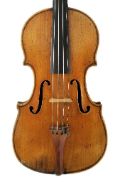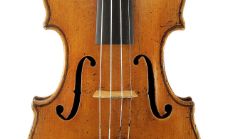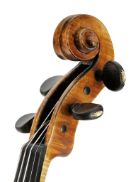Violin, Giovanni Battista Guadagnini, Turin, 177.
Printed label: “Joannes Baptista Guadagnini / Cremonensis fecit Taurini / alumnus Antoni Stradivari 177.” [cross as well as the initials GBG]The printed label of this violin is very soiled, making the last numeral of the year particularly hard to read – perhaps “8.” However, stylistic features confirm beyond question that the violin was made during Guadagnini’s last period in Turin. A comparison with the 1776 violin demonstrates that Guadagnini continued to experiment even throughout the last part of his career. Although both instruments are constructed on the same model, possibly even on the same inner mold, the corners are far shorter on this violin. Its f-holes are several millimeters longer than those of the 1776 violin, and above all the wing design is reminiscent of Giuseppe Guarneri del Gesù’s work. The wood of the divided belly is wide-grained and exhibits very regular growth. A dendrochronological analysis showed that wood from different trees was used, and that the youngest tree ring was dated to 1770. The slab-cut back exhibits magnificent, vivid flames. By contrast, the ribs are quarter cut and more tightly flamed. The arching extends far to the edges, letting it appear very full. It transitions to shallow fluting leading to the edge. The very high f-holes have small, perfectly round eyes and very individually formed wings. The purfling is wide and somewhat irregular in execution on the back. Like Stradivari, Guadagnini blackened the chamfers of the very delicate scroll. The volutes angle off somewhat on either side of the scroll. The golden-yellow ground is covered by a luminous, transparent color varnish that is still well preserved, especially on the back. The overall condition of the instrument is very good.






